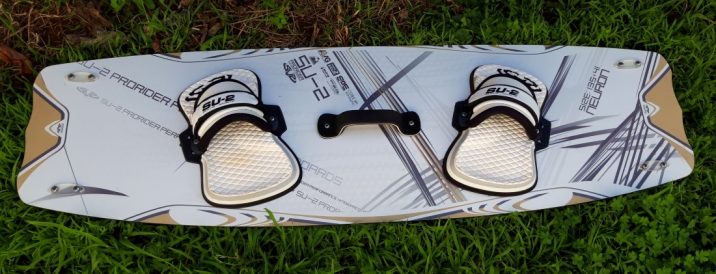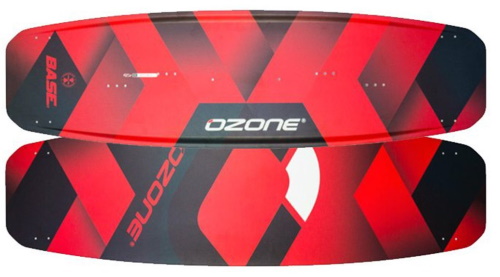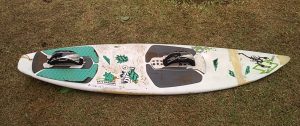A question that comes up a lot among newer kiteboarders is which size kiteboard to choose for an 85kg (185+lb) rider. There isn’t a single, clear-cut answer to this question as a few factors need to be taken into account besides weight, such as riding style, wind conditions, kite size, rider experience
What size kiteboard should an 85 kg rider pick? Go for a shorter and wider board (e.g. 132x42cm) if you’re shorter, for serious new school tricks, or if you like riding overpowered. Choose a slightly longer (e.g. 138-140cm), rockered kiteboard if you’re a taller rider, if you mostly freeride with light jumps, or if you ride low-to-moderately powered or in light winds.
There are several factors to consider when choosing the right kiteboard size for an 85 kg rider. In this post, we’ll look at actual examples of board sizes these riders actually ride, and we try to understand the various aspects that impact your board size choice.
Check out the kiteboard sizes here at Green Hat
NOTE: if you’re a beginner kiteboarder, make sure you wear good kiting sunglasses. As a newbie, you’re constantly looking at your kite and into direct sunlight, which can have a nasty impact on your eyes. Check out this post for more.
Board size examples for 85 kg
Most 85 kg kiteboarders who are not complete beginners choose a kiteboard length in the 132-144cm range and width in the 41-45cm range. While shorter boards are more nimble for transitions and tricks, wider boards give you better planing and smoother landings in jumps. Boards with less surface are easier to control in strong winds or with big kites, while rockered boards ride smoother in chop.
Here are a few examples of board size choice for riders around 85 kg:
| Rider size | Board size |
|---|---|
| 78 kg rider (1.85m) | went from 132x40 for several years to 134x42 with more rocker - much more forgiving, better stance since it's wider. |
| 80 kg rider (1.83m) | 134x44 Nobile kiteboard |
| 82 kg rider | 135x42 Shinn Monk. Very happy with the board, never loses control in any winds 15-35 knots. Board works great in chop, is easy on the knees, has comfortable pads and straps, turns nicely and carves well with little spray in the face. |
| 84 kg rider (1.74m) | Nobile 132x40 kiteboard. Can ride it in as low as 15knots with a 8m Switchblade kite. |
| 85 kg rider | 128 ProX for wake style (boots) and 140 Cabrinha for freestyle. |
| 85 kg rider | 136x41 Cabrinha Spectrum |
| 85 kg rider | 134x42 Shinn Monk |
| 86 kg rider | 145x41 kiteboard for normal wind, 138x40.5 board for strong wind (rarely ridden), 160x45 for really light wind |
| 90 kg rider | 138x42 and 142x43 boards (lots of pop) |
| 105 kg rider | 134x41 board Xenon board |
Board length vs surface area
Beyond length, what matters the most in choosing the best kiteboard size for an 85 kg rider is overall board surface area. The width of your kiteboard is actually as important, if not more, than the length.
Width impacts the way the kiteboard feels when doing transitions and jumps. For a rider around 85 kg, a relatively short board (135-139cm) that’s wider (42-44cm) can work very well in average winds. A board 1cm wider may feel like an extra 5cm in length. Board surface is what helps you get up planing quicker (ignoring other variables such as flex and rocker).
So extra width gives you that extra surface area you need for speed and landings, without the added length which may make the board bulkier and less maneuverable in tricks and transitions.
Keep in mind, though, that too wide a board may also negatively impact your riding as it will build up too much speed and skid instead of carving when overpowered (stronger wind or bigger kite).
For a given weight (85 kg in our case), you should also take into account your height when choosing the right length-to-width ratio: a taller rider should choose a slightly longer and narrower board for a natural stance.
Impact of kite size on board size
Another key aspect to consider when choosing the right board size for your weight is how you like to ride in terms of kite power. If you enjoy riding slightly overpowered with a bigger kite relative to wind force (e.g. using a 12m kite in 20 knots), then you want a smaller kiteboard, e.g. 132x40cm, to make up for that extra power and more easily edge and hold to control the kite power.
On the other hand, if you like to ride with just the right amount of power (e.g. a 9m kite in steady 17-18 knot wind) then you may opt for a bigger board such as 138x42cm.
So what it comes down to when deciding within the size range I mentioned, is which combination of kite size, wind speed, and board size works best for you – this may also vary based on your own mood! So on a given day, you may opt for your 14m kite with your 128cm board, or alternatively, your 10m kite with your 136cm board.
You may notice kiteboards have
With added rocker, these larger boards also cut much better through chop and with lower impact on the knees. Rocker effectively reduces the contact surface between the board and water, so a rockered board may be wider without necessarily being too big.
Old school vs new school
One last aspect I want to mention regarding choosing the right board size is riding style. New school kiteboarding involves lots of snowboard-like tricks and flips that often require a wider stance, whereas old school tricks (involving a lot of board-offs) needed to be shorter.
Sor for an 85 kg rider with a mixed freestyle/freeride kiting style, a 135-140cm board is standard. If you wish to work on more hardcore wakestyle tricks, you may opt for a shorter, 128-132cm board – again, width will depend on your height and you power riding preferences.
As I’ve mentioned a moment ago, width and rocker can allow you to go bigger without impacting wind range and planing ability. Rocker will reduce contact and so will keep you from being overpowered quickly. It will also provide more comfort when loading up for tricks in choppy conditions. A wider board will let you land jumps much more smoothly thanks to the large surface area, but without sacrificing the snappy feel
Check out the kiteboard sizes here at Green Hat
Summary
Choosing the right kiteboard size for a given weight and height is tricky due to the many factors that impact the decision. Ultimately, you’ll develop a feeling for the kind of board that works best for you by testing a wide range of kiteboards. Your preferences in terms of kiteboard will also evolve over time as you gain experience and start to focus on specific riding styles (tricks, surf, freeride) and/or conditions (moderate vs strong winds, flatwater vs waves etc).





Board size is just as important as getting the right size kite. I have to have a light wind specific board in my car at all times. Even with a kite like the Best TS or the Cabrinha Crossbow, big riders need a board that will glide through the lulls. In the wind at 15MPH with 3MPH lulls, rocker in your board will crush your rate of speed and you will be slogging around. Be sure you are able to stay on plane, and learn when to edge your flat board and when to ride it flat on the water with the fins to control your direction.
Awesome comment and advice, thanks!